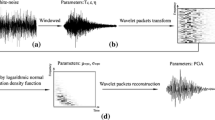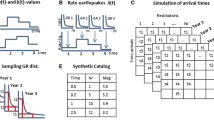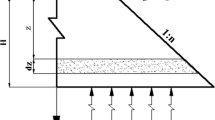Abstract
To improve the accuracy with which the non-stationary intensity characteristics of artificial acceleration-time-history curves are determined, a method of adjusting the frequency correlation between the artificial peak arrival time and amplitude spectrum is proposed. A calculation method for determining the peak arrival time to reflect the physical meaning of the phase-difference spectrum was first deduced. Subsequently, the amplitude-distribution characteristics corresponding to the peak arrival times for different durations of natural earthquakes were analyzed. In accordance with the distribution characteristics of the reference amplitude, the frequency distribution of the artificial peak arrival time was divided into four parts: the beginning, strong-earthquake, attenuation, and tail sections. By adjusting the arrival frequency of peak points for the different earthquake durations considered, the corresponding relationship between the artificial peak arrival time and amplitude spectrum was determined to be more consistent with the general law of natural earthquakes. The sample calculation described in this paper demonstrates that adjusting the frequency correspondence between the artificial peak arrival time and amplitude spectrum greatly improves the accuracy of the non-stationary intensity characteristics of artificial acceleration-time-history curves.
Similar content being viewed by others
References
Ai, X. and Li, J. (2009). “Research on the synthesis of ground motion based on random fourier spectrum.” Earthquake Engineering and Engineering Vibration, Vol. 29, No. 2, pp. 7–12, DOI: https://doi.org/10.13197/j.eeev.2009.02.002.
Ancheta, T. D., Darragh, R. B., Stewart, J. P., Seyhan, E., Silva, W. J., Chiou, B. S., Wooddell, K. E., Graves, R. W., Kottke, A. R., Boore, D. M., and Kishida, T. (2014). “NGA-West2 database.” Earthquake Spectra, Vol. 30, No. 3, pp. 989–1005, DOI: https://doi.org/10.1193/070913EQS197M.
Arias, A. (1970). “A measure of earthquake intensity.” Seismic Design of Nuclear Power Plants, MIT Press, MA, USA, pp. 438–483, ResearchGate.
Cheng, W., Liu, G., and Yi, W. (1999). “Study of properties of phase spectrum and phase difference spectrum of strong ground motions.” Journal of Hunan University (Natural Sciences Edition), Hunan, China, Vol. 2, pp. 82–91.
Dong, D., Zhou, X., Xu, G., and Yang, R. (2006). “Some studies on frequency non-stationary of strong earthquake records.” Earthquake Engineering and Engineering Vibration, Vol. 1, pp. 22–29, DOI: https://doi.org/10.13197/j.eeev.2006.01.004.
Jin, X. and Liao, Z. (1993). “Study on the phase special position of ground motion.” Earthquake Engineering and Engineering Vibration, Vol. 13, No. 1, pp. 7–13, DOI: https://doi.org/10.13197/j.eeev.1993.01.002.
Jones, L., Aki, K., and Boore, D. (1994). “The magnitude 6.7 Northridge, California earthquake of 17 January 1994.” Science, Vol. 266, No. 5184, pp. 389–397, DOI: https://doi.org/10.1126/science.266.5184.389.
Ohsaki, Y. (1979). “Significance of phase content in earthquake ground motions.” Earthquake Engineering and Structural Dynamics, Vol. 7, No. 5, pp. 427–439, DOI: https://doi.org/10.1002/eqe.4290070504.
Sato, T., Murono, Y., Wang, H. B., and Nishimura, A. (2001). “Design spectra and phase spectrum modeling to simulate design earthquake motions: A case study through design standards of railway facilities in Japan.” Journal of Natural Disaster Science, Vol. 23, No. 2, pp. 89–100, View at Google.
Scanlan, R. H. and Sachs, K. (1974). “Earthquake time histories and response spectra.” Journal of Engineering Mechanics, Vol. 100, No. 4, pp. 635–655.
Thrainsson, H. and Kiremidjian, A. S. (2002). “Simulation of digital earthquake accelerograms using the inverse discrete Fourier transform.” Earthquake Engineering Structures, Vol. 31, No. 12, pp. 2023–2048, DOI: https://doi.org/10.1002/eqe.198.
Wang, J. J., Fan, L. C., Qian, S., and Zhou, J. (2002). “Simulations of non-stationary frequency content and its importance to seismic assessment of structures.” Earthquake Engineering Structures, Vol. 31, No. 4, pp. 993–1005, DOI: https://doi.org/10.1002/eqe.134.
Zhang, C., Sato, T., and Lu, L. Y. Zhang, C., Sato, T., and Lu, L. Y. (2011). “A phase model of earthquake motions based on stochastic differential equation.” KSCE Journal of Civil Engineering, KSCE, Vol. 15, No. 1, pp. 161–166, DOI: https://doi.org/10.1007/s12205-011-1074-3.
Acknowledgements
Not Applicable
Author information
Authors and Affiliations
Corresponding author
Rights and permissions
About this article
Cite this article
Han, X., Wang, Z., Peng, L. et al. Numerical Simulation of Seismic Waves with Peak Arrival Time and Amplitude-Frequency Correlation. KSCE J Civ Eng 23, 4389–4406 (2019). https://doi.org/10.1007/s12205-019-1927-8
Received:
Revised:
Accepted:
Published:
Issue Date:
DOI: https://doi.org/10.1007/s12205-019-1927-8




